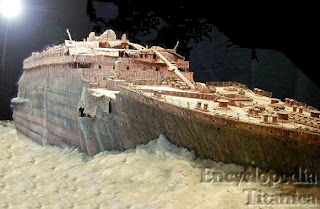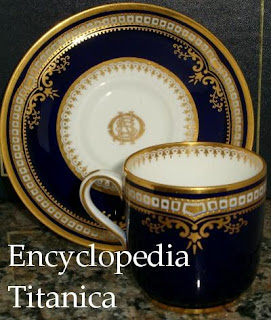


Letter from museum received - great excitement! The letter says that we have been granted permission to salvage artefacts from The Titanic that belonged to The White Star Line, but we would have to obtain a special licence to salvage personal items from passengers and crew (obtainable from 'The Titanic Relatives Society.) The museum did say that they would be particularly interested if we could get this licence and would pay us substantially more for the salvage!! They would also like us to restore and research the objects found.
We had a long discussion about this, ending in two opposing factions - those who thought we should just salvage WSL objects and those who thought we should try to get the extra license. We had previously watched a video of one of real scientific expeditions to The Titanic, during which an argument ensued about whether the team should pick up a suitcase found on the sea bed. One of the guys had said 'it's not in our contract - it's not ours to touch!" and the children were fascinated by this - it certainly affected the viewpoints of some of the class who agreed with him. They were also adamant that they were not in it for the money! The other side were not just motivated by greed, however - some of them thought it was important for people to see these things 'it's the most interesting bit' someone said. They also believed that it would be ethically sound as long as the relatives society agreed. Eventually, about 2/3 of the class agreed to write to ask for the licence. I contracted the others into still going ahead with the dive but them being responsible for picking up the WSL stuff - they were happy with this.
The next day we received a letter and licence from 'The Titanic Relatives Society'. They said they thought it was important for people to know about what happened and they were happy for us to salvage personal objects - they also thought they might be able to find out more about their relatives from us.
We could now begin to plan for the dive. We worked together to make a list of what we needed to do to prepare. We also talked about potential dangers - we had seen on the video a minor accident where the sub hit part of the wreckage. The team had immediately decided to return to the surface beacsue of presure on the sub's roof. One of the team had also talked about being trapped 'it would take us about 3 days to freeze to death', he said. I asked, at this point, if there was anyone not willing to face the dangers of the dive. About 6 people weren't so they opted to stay at mission control on the salvage ship during the dive.
At this point someone reminded me that we hadn't done any submersible training - our last few dives have all been free diving. So we decided to run a re-training session. we sorted ourselves into sub teams, each with a driver, a robotic arm worker, a viewer, a photographer and a radio operator. I acted as sub trainer and we watched each sub as I asked them to demonstrate moving round underwater; using the robotic arms; reporting a view seen through the monitor; taking a photograph and reporting back to me via the radio. The rest of the group fed back to each sub team 2 examples of good work and an area to improve on.
Huge engagement here - I was so impressed with the way the teams sorted themselves out with the jobs - I dodn't need to intervene at all - their collaboration was something to be seen today. The feedback worked really well too. They had remembered a previous rule we had worked out together that we don't name individuals who need to improve - just using a generic term e.g. 'some people need to ....'.
At this point the teams had decided there should definitely be some specific rules for this dive as it was pretty special. Each team came up with their own set of rules. I thought it might be a good idea to feep a record of each team's mission so I'd made big sugar paper folders to put all the information about t he dive in. I took photos of each team, posing proudly and they wrote their names and jobs on the folders. They then worked together to draw their subs (They all had unique features!) and all the equipment they would need for the dive. There was a big discussion about where the robotic arms actually placed the salvaged artefacts, so we had various ingeneous inventions including airtight compartments and special boxes attached to the top of the sub.
OK - we were ready for the dive. I wanted to start this soon after register - it just seemed like the most important thing on all our minds so we got on with it staright away. We drew the curtains to make it as dark as possible. The teams positioned themsleves in their subs. The room was hushed. One team worked on the salvage ship, sorting equipment and preparing for the objects that would be brought back up. I was on the radio at mission control receiving messages from each sub and asking questions about what was going on. Suddenly someone reported a dim shape in the distance. It was The Titanic. At this point I froze the action. I asked each sub team to agree on which part of the ship they could see. Some said they were above the main deck, some at the bow of the stern, one team near the mast where the reamins of the crows nest could still be seen. (No need to remind anyone of the technical language - it was all there!). Then I asked the photographers to take pictures of what they could see. I also did some thought tracking - asking individuals how they were feeling / what they were thinking. 'I've never felt like this before' said someone.
Then the distress signal came - SOS from the team near the bow - 'some wreckage has fallen on us - we're trapped!' We stopped the action for a moment and I asked the trapped team to come to the middle of the room while the rest of us sat in a circle around them. I then asked them to position themselves as they were just before the accident happened - then to move in slow motion to how they looked just after the accident. (I love this convention - very powerful watching the change - it was all quite subtle actually.) The teams then questioned the trapped team about waht was happening - it transpired that there was a large piece of wreckage on top of the sub. There was still a couple of hours worth of oxygen, but the emergency supply had been damaged. The crew were feeling calm but worried. They were pretty cold too.
We then needed to agree what to do. Each team decided to go off to plan a rescue, including the salvage ship team who decided to send down a remote control sub. Two teams decided to work together on the rescue. Then each rescue was carried out with the rest of the group watching. I asked a member of the trapped team to put up a hand when they felt the rescue had been achieved. It was taking a while with some of the teams so we decided to do a countdown - luckily a hand went up each time - sometimes precariously close to the end - it was pretty tense! The first part of the dive had to stop at this point.
Next day we reviewed what had happened. The teams were pretty proud of the rescue operation - we used the good old blob tree to discuss how we were feeling at different times during the first part of the dive and the rescue. We then recieved a phone call from HQ in Cromer saying that accident and rescue reports needed to be filled in for company records. The session was spent filling in report forms and also drawing the 'photographs' of the first view of The Titanic and adding personal captions (relating to the thought tracking). These were all stored in the team folders.
The dive now needed to continue - time for the actual retrieval of objects. The teams worked busily, picking up objects, taking photos and reporting back on the radio what they were finding. The teams returned to the salvage ship regularly with baskets of objects and the ship teamworked to store them and lable them on board. At the end of this session they drew the artefacts they had found, noting the condition. There were a few mystery objects that could not be identified. They were pleased at the end of this that only a couple of items had been damaged, not through clumsiness, but because the objects were so badly decayed. (Drawing on knowledge here from our salt water test!).
I was really pleased with the big dive so far - I really think we've reached obsession mode here - the children are loving every minute of it and takin gthe work so seriously. I'm seriously proud of them!




